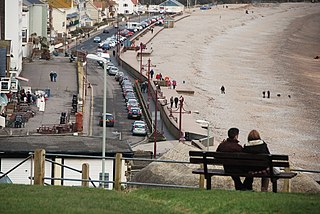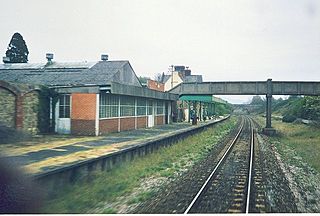
Mitcham Junction is a National Rail station served by Southern and Thameslink trains, and a Tramlink stop. It is in the London Borough of Merton and is in Travelcard Zone 4.

Seaton is a seaside town, fishing harbour and civil parish in East Devon on the south coast of England, between Axmouth and Beer. It faces onto Lyme Bay and is on the Dorset and East Devon Coast Jurassic Coast World Heritage Site. A sea wall provides access to the mostly shingle beach stretching for about a mile, and a small harbour, located mainly in the Axmouth area.

Wimbledon is a National Rail, London Underground, and Tramlink station located on Wimbledon Bridge, Wimbledon in London, and is the only station in London that provides an interchange between the London Underground and Tramlink. The station serves as a junction for services from the Underground's District line and National Rail operators, as well as Tramlink services. The station is in Travelcard Zone 3. It is 7 miles 19 chains (11.6 km) from London Waterloo on the South West Main Line.

Goodwood railway station is the junction station for the Belair, Seaford and Flinders lines. The Belair line diverges south-east towards Millswood, while the Seaford and Flinders lines diverge south-west towards Clarence Park. The Glenelg tram line crosses over the railway lines at the south end of Goodwood station. The station services the Adelaide inner-southern suburb of Goodwood, and is 5.0 km from Adelaide station.

Melbourne tram route 96 is operated by Yarra Trams on the Melbourne tram network from Brunswick East to St Kilda Beach. The 13.9 kilometre route is operated out of Southbank depot with C2, E class, and on occasion A class trams.

The Avocet Line is the railway line in Devon, England connecting Exeter with Exmouth. It was originally built by the London and South Western Railway, and was historically known as the Exmouth branch railway. The line follows the Exe Estuary for about half of its route, from just outside Topsham to Exmouth, giving views of the estuary. The line is named after the pied avocet, which lives in the estuary.

Ravenscourt Park is a London Underground station located in west Hammersmith, west London. The station is served by the District line and is between Hammersmith and Stamford Brook stations.

The Seaton Tramway is a 2 ft 9 in narrow gauge electric tramway in the East Devon district of South West England. The 3-mile (4.8 km) route runs alongside the Axe Estuary and the River Coly, running between the coastal resort of Seaton, the village of Colyford, and the ancient town of Colyton. For much of its route, it operates between the estuary and the Seaton Wetlands nature reserves, offering views of the wildlife of both.
The Glasgow and Paisley Joint Railway was the section of railway line between Glasgow Bridge Street railway station and Paisley, in the west of Scotland. It was constructed and operated jointly by two competing railway companies as the stem of their lines to Greenock and Ayr respectively, and it opened in 1840. The Joint Committee, which controlled the line, built a branch to Govan and later to Cessnock Dock, and then Prince's Dock.

Corfe Castle railway station is a railway station located in the village of Corfe Castle, in the English county of Dorset. Originally an intermediate station on the London and South Western Railway (L&SWR) branch line from Wareham to Swanage, the line and station were closed by British Rail in 1972. It has since reopened as a station on the Swanage Railway, a heritage railway that runs regularly from Norden station just north of Corfe Castle to Swanage station. The line also connects Wareham and Norden.

Colyton is a town in Devon, England. It is located within the East Devon local authority area, the river River Coly runs through it. It is 3 miles (5 km) from Seaton and 6 miles (10 km) from Axminster. Its population in 1991 was 2,783, reducing to 2,105 at the 2011 Census. Colyton is a major part of the Coly Valley electoral ward. The ward population at the above census was 4,493.

Colyford is a village and civil parish in the East Devon district, in the county of Devon, England. It is situated midway between Lyme Regis and Sidmouth on the A3052 road. To the north the village borders the town Colyton. To the south is the seaside resort town Seaton, separated from Colyford by the Seaton Wetlands, a series of nature reserves flanking the estuary of the River Axe. Colyford lies on the River Coly, which flows into the River Axe immediately to the east of the village.
This article describes the history and operation of the railway routes west of Salisbury built by the London and South Western Railway (LSWR) and allied companies, which ultimately became part of the Southern Railway in the United Kingdom. Salisbury forms a natural boundary between the Southern Railway core routes in the counties surrounding London, and the long route connecting with the Devon and Cornwall lines.

The Chard branch lines were two lines serving the town of Chard in Somerset, England. One was a northward branch, opened in 1863, from the Salisbury to Exeter main line, and the other, opened in 1866, ran south-eastwards from the Bristol – Taunton main line. Each branch had its own Chard passenger station at first, although the two lines connected in Chard.

Seaton Junction is a closed railway station on the West of England Main Line from London Waterloo to Exeter. It was situated 3 miles west of Axminster and 7 miles east of Honiton. It was previously known as Colyton for Seaton and Colyton Junction.
The Seaton branch line was a railway branch line connecting the seaside resort of Seaton, Devon, in England, to the main line network at Seaton Junction railway station, on the main line between Salisbury and Exeter.
The Yeovil–Taunton line was a railway line in England, built by the Bristol and Exeter Railway (B&ER) to connect its main line with the market town of Yeovil in Somerset. It opened in 1853 using the broad gauge of 7 ft 1⁄4 in and was the first railway to serve Yeovil. It ran from a junction at Durston although in later years passenger trains on the line ran through to and from Taunton where better main and branch line connections could be made.
Seaton railway station served the holiday resort of Seaton in Devon, England between 1868 and 1966. It was the terminus of a branch line from Seaton Junction. The station was about half a mile east of the centre of Seaton, on the western side of the estuary of the River Axe. Originally named Seaton and Beer, it was renamed Seaton by the LSWR.

Colyton railway station, and its successor the Colyton tram stop, serve the town of Colyton in Devon, England. It was open as a railway station, on the Seaton branch line, between 1868 and 1966, and has been open as a tram stop, on the Seaton Tramway, since 1980. The station is situated some 0.5 miles (0.80 km) to the east of Colyton town centre.

The Seaton tramway station is the southern terminus of the Seaton Tramway. The station is situated in the town centre of the town of Seaton in the English county of Devon. The terminus at Seaton opened in 1975, and has since been entirely rebuilt twice. The most recent rebuilding has resulted in the construction of a modern enclosed building suitable for operation all-year round, and which acts as a venue for a range of tramway and community based events.
















